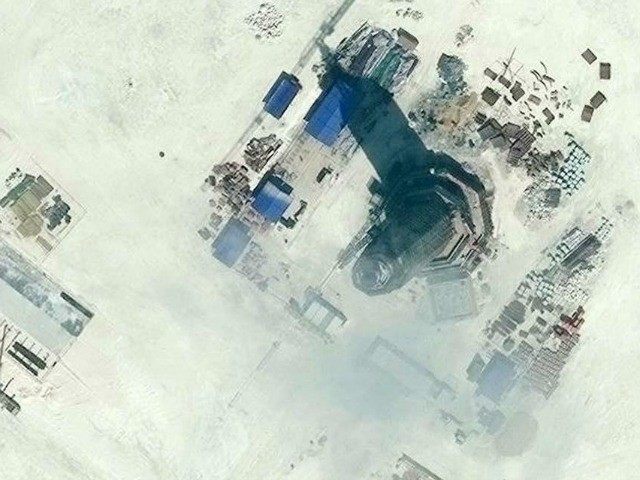Chinese media outlet Xinhua has confirmed that a third illegally constructed lighthouse in the South China Sea is now fully operational. The lighthouse is located on the artificial island formerly known as Subi Reef and equipped with “automatic identification systems” that significantly expand China’s surveillance capabilities.
The Chinese government announced the official opening of the lighthouse with a “completion ceremony” Tuesday night in a photo essay on state media outlet Xinhua. Xinhua noted that the new lighthouse “can provide efficient navigation services such as positioning reference, route guidance and navigation safety information to ships, which can improve navigation management and emergency response.”

It can also expand China’s ability to keep track of vessels navigating through the Spratly Islands significantly. Ministry of Transport Deputy Director Zheng Heping told China Radio International Wednesday that the lighthouse “is equipped with automatic identification system and very high frequency stations.”
The lighthouse’s functionality is likely to increase regional concerns of Chinese expansionism in the region. Beijing claims nearly all of the maritime territory in the South China Sea, including the Spratly and Paracel Islands. Its claims overlap with those of Malaysia, Brunei, Vietnam, the Philippines, and Taiwan, which China does not acknowledge as a sovereign nation. The Philippines and Vietnam both contest the Spratly Islands, and the Philippines has lodged a case at the Permanent Court of Arbitration at The Hague against China’s territorial claims. China has vowed to ignore any verdict the court reaches.
Foreign Ministry spokesman Lu Kang said the lighthouse was necessary because “high traffic density, complex navigation condition, severe shortage in aids and response forces have combined to threaten navigation safety and hindered economic and social development in the region.”
The new lighthouse was built on Subi Reef, formerly partially underwater but now an artificial island. Reuters notes that China appears to intend to use the island to establish a 12-nautical-mile exclusive economic zone in the region, which would prevent other international actors from fishing there or exploiting other resources. International law explicitly prohibits the use of reefs in such a way, however.
The Diplomat also highlights that Subi Reef has become a target of American freedom of navigation exercises, which aim to eliminate the threat of Chinese hegemony in the region. In October, the United States Navy’s USS Lassen sailed within 12 nautical miles of the reef, a move China alleged threatened its “sovereignty and security interest, and has put the safety of personnel on the reefs in danger.” American officials have responded by urging China to become accustomed to such moves, as they are to become “routine.” Construction of the lighthouse on Subi Reef began that very month.
Sticking to the U.S. Navy mantra of “we’ll fly, sail and operate wherever international law allows,” U.S. Pacific Command head Admiral Harry Harris insisted in February that America will continue such operations “with greater complexity in the future.” He dismissed Chinese officials’ accusations that America is seeking to militarize the South China Sea, instead noting, “China’s intent to militarize the South China Sea is as certain as a traffic jam in DC.”
The United States will also participate in combat drills with Philippine and Australian troops designed to “prepare to quickly respond to a range of potential crises, including in the disputed South China Sea,” according to the Associated Press. U.S. Defense Secretary Ash Carter is expected to personally oversee some of the exercises, his presence in the region intended to “reaffirm that the relationship that we have with the Philippines is rock solid and we’re side by side,” according to U.S. Marine Lt. Gen. John Toolan.
In addition to this coalition, the Japanese government recently announced that it will dispatch a destroyer to a joint military exercise in the region with Indonesia. The destroyer will be in the region between April 12-16.

COMMENTS
Please let us know if you're having issues with commenting.